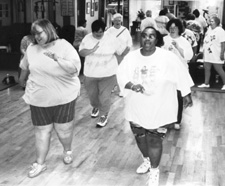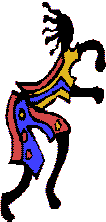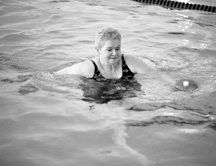Be Active at Any Size Publication: http://win.niddk.nih.gov/publications/active.htm Explore overcoming barriers, journal-keeping ideas, and many tips!
 |
|
|
|
|
|
|
|
Active at Any Size
|
Do you feel that you can barely do any activity at all? That you can’t exercise, play sports, or become more fit?
Facing these challenges is hard—but it can be done! This booklet can
help you start being more active and healthier—no matter what your size! |
|
|
Why
should I be active?
|
Being
active helps you
live longer
and protects you from:
Regular physical activity helps you feel better because it:
Being active can be big fun! |
|
|
How
do I get started? Appreciate Yourself! If you can’t do an activity, don’t be hard on yourself. Feel good about what you can do. Be proud of pushing yourself up out of a chair or walking a short distance. Pat yourself on the back for trying even if you can’t do it the first time. It may be easier the next time! |
To start being more active and keep at it:
|
|
|
What
physical activities can a very large person do? Do I need to see my health care provider before I start exercising?
You should see your
doctor if: —you have not been active for years —you are active now and are changing from a moderate to a more intense activity —you have diabetes, heart disease, or high blood pressure —you have arthritis or an injury (like a knee injury).
|
You can do:
Exercise or physical activity does not have to be hard or boring to be good for you. Anything that gets you moving around—even for only a few minutes a day—is a healthy start to getting more fit. Most very large people can do some or all of the activities in this booklet. You don’t need special skills or a lot of equipment. This booklet describes both weight bearing and non-weight bearing activities. Weight bearing activities, like walking, bowling, and golfing involve lifting or pushing your own body weight. Non-weight bearing activities, like swimming, put less stress on your joints because you don’t have to lift or push your own weight. If your feet or joints hurt when you stand, non-weight bearing activities may be best for you.
|
|
|
Gentle
activity is healthy. You don’t have to push yourself to benefit from physical activity. Thirty minutes of gentle activity (like walking) can be just as healthy as 15 minutes of intense activity (like fast dancing). |
Walking (weight bearing)
The walking that you do during the day (like doing chores around the house or in the yard) can help you be more fit. But regular, steady walking that makes you breathe heavier can help you to be healthier. It will give your heart and lungs—as well as your leg muscles—a good workout. If you are not active now, start slowly. Try to walk 5 minutes a day for the first week. Walk 8 minutes the next week. Stay at 8–minute walks until you feel comfortable. Then increase your walks to 11 minutes. Slowly lengthen each walk by 3 minutes—or walk faster. Tips for walking:
(To learn more, see WIN’s pamphlet Walking...A Step in the Right Direction.)
|
|
|
Where to exercise. You can do many activities in your home. But there are other fun ways to be active in health clubs, in recreation centers, or outdoors. It may be hard to be active around other people. Keep in mind that you have just as much right to be healthy and active as anyone else. |
Dancing helps:
You can dance in a health club, in a nightclub, or at home. To dance at home, just move your body to some lively music! Dancing on your feet is a weight bearing activity. Dancing while seated lets you move your arms and legs to music while taking the weight off your feet. This may be a good choice if you can’t stand on your feet very long. (See the list of resources at the end of this booklet for seated workout videos.)
Water Workouts (non-weightbearing) Exercising in water helps you feel: Flexible. You can bend and move your body in water in ways you can’t on land. Strong. Working against the water will help your body get stronger. At less risk of injury. Water makes your body float. This keeps your joints from being pounded or jarred and helps prevent sore muscles and injury. Refreshed. You can keep cooler in water—even when you are working hard. You don’t need to know how to swim to work out in water—you can do shallow-water or deep-water exercises without swimming. For shallow-water exercise, the water level should be between your waist and your chest. If the water is too shallow, it will be hard to move your arms underwater. If the water is deeper than chest height, it will be hard to keep your feet touching the pool bottom. For deep-water exercise, most of your body is underwater. This means that your whole body will get a good workout. For safety and comfort, wear a foam belt or life jacket. Many swim centers offer classes in water workouts. Check with the ones in your area to find the best water workout for you. (See the list of resources at the end of this booklet to learn more about water exercises.) |
|
|
Weight training rule of thumb. If you can’t do an exercise 8 times in a row, your weights are too heavy. If it is easy to do it 12 times in a row, your weights are too light. |
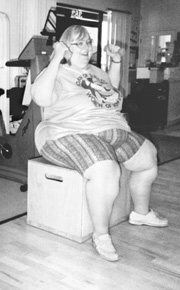 Weight
Training (weight
bearing or non-weight bearing) Weight
Training (weight
bearing or non-weight bearing)
Weight training builds strong muscles and bones. You can weight train at home or at a fitness center. You don’t need benches or bars to begin weight training at home. You can use a pair of hand weights or even two soup cans. Make sure you know the correct posture and that your movements are slow and controlled. Before you buy a home gym, check its weight rating (the number of pounds it can support) to make sure it is safe for your size. If you want to join a fitness center where you can use weights, shop around for one where you feel at ease. (To learn more about weight training, see the list of resources at the end of this booklet.)
Bicycling (non-weight bearing) You can bicycle indoors on an exercise bike, or outdoors on a road bike. Biking does not stress any one part of the body—your weight is spread between your arms, back, and hips. You may want to use a recumbent bike. On this type of bike, you sit low to the ground with your legs reaching forward to the pedals. This may feel better than sitting upright. The seat on a recumbent bike is also wider than the seat on an upright bike. For biking outdoors, you may want to try a mountain bike. These bikes have wider tires and are heavy. You can also buy a larger seat to put on your bike.
Make sure the bike you buy has a weight rating at least as high as
your own weight. (To learn more about bicycling, see the list of resources at the end of this booklet.) |
|
|
Questions to ask when choosing a fitness center. —Can the treadmills or benches support people who are large? —Do the fitness staff know how to work with people of larger sizes? —Can I take time to see how I like the center before I sign up? —Is the aim to have fun and get healthy—not to lose weight? |
Stretching (weight bearing or non-weight bearing) Stretching helps:
You don’t have to set aside a special time or place to stretch. At home or at work, stand up, push your arms toward the ceiling, and stretch. Stretch slowly and only enough to feel tightness—not until you feel pain. Hold the stretch, without bouncing, for about 30 seconds. Don’t stretch cold muscles Yoga and tai chi are types of stretching. They help you breath deeply, relax, and get rid of stress. Your local fitness center may offer yoga, tai chi, or other stretching classes. You may want to start with “gentle” classes, like those aimed at seniors. (See the list of resources at the end of this booklet to learn more about these exercises for large people.)
|
|
|
Applaud yourself! If you can do only a few or none of these activities, it’s OK. Remember to appreciate what you can do, even if you think it’s a small amount. Just moving any part of your body—even for a short time—can make you healthier. |
Your activities do not have to be planned. You can make small day-to-day changes to improve your health. For example,
Doing chores like lawn mowing, leaf raking, gardening, and housework can also improve your health. |
|
|
Safety Tips
Drink plenty of water. Water helps every cell and organ in your body work. It cushions your joints, improves your bowel patterns, and keeps your body cool. |
Try these tips to exercise safely.
Healthy, fit bodies come in all sizes.
Whatever your size or shape, start exercising now and keep moving
for a healthier life!
|
|
|
Inclusion of resources is for information only and does not imply endorsement by the Government. |
Publications (Fitness-Related)
Walking . . . A Step in the Right Direction. Great Shape - The First Fitness Guide For Large Women, by Pat Lyons and Debby Burgard, (2002), iUniverse.com Publisher, Emphasizes the pleasure and enjoyment of an active, healthy life, rather than concentrating on losing weight. Describes walking, dancing, swimming, aerobic activity, bicycling, and includes valuable safety tips. Boosts self-esteem and restores self-confidence. Tells where to find the right books, clothes, classes, organizations, and videotapes. Available from www.Amazon.com . Visit also www.bodypositive.com .
Just the Weigh You Are: How to Be Fit and Healthy Whatever Your Size.
Don’t Weight: Eat Healthy and Get Moving NOW!
Water Exercise.
Easy Does It Yoga.
Other Publications
Ample Hygiene for Ample People.
Sandie’s Clothesline.
Size Wise: A Catalog of More Than 1000
Resources for Living With Confidence and Comfort at Any Size. Videos
Yoga for Large People.
Chair Dancing.
Tai Chi Chuan. Organizations and Programs
YMCA and YWCA.
Council on Size and Weight Discrimination, Inc.
National Association to Advance Fat Acceptance. Websites
Body Positive.®
Big Folks Exercise and Fitness Resources Frequently Asked Questions
(FAQ).
Healthy Living with Bliss.™
Special thanks to the Women of Substance Health Spa for providing many of the photographs in this brochure. |
|
Weight-control
Information Network
1 Win Way
|
||
|
|
NIH Publication No.
00-4352 March 2001 |

 Very
large people face special challenges in trying to be active. You may not
be able to bend or move in the same way that other people can. It may be
hard to find clothes and equipment for exercising. You may feel
self-conscious being active around other people.
Very
large people face special challenges in trying to be active. You may not
be able to bend or move in the same way that other people can. It may be
hard to find clothes and equipment for exercising. You may feel
self-conscious being active around other people.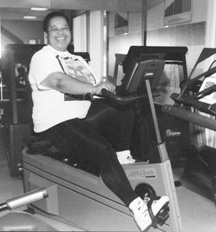 If
you have one of these problems, being active may help control the
problem.
If
you have one of these problems, being active may help control the
problem.